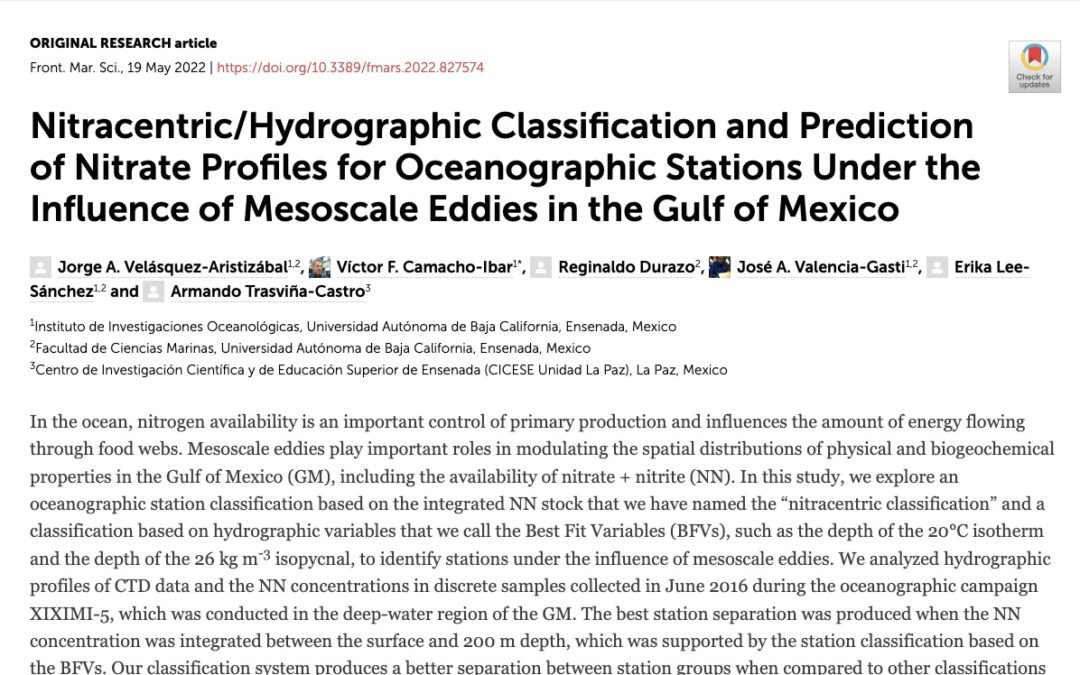Authors: Jorge A. Velásquez-Aristizábal, Víctor F. Camacho-Ibar, Reginaldo Durazo, José A. Valencia-Gasti, Erika Lee-Sánchez y Armando Trasviña-Castro
https://doi.org/10.3389/fmars.2022.827574
Abstract
In the ocean, nitrogen availability is an important control of primary production and influences the amount of energy flowing through food webs. Mesoscale eddies play important roles in modulating the spatial distributions of physical and biogeochemical properties in the Gulf of Mexico (GM), including the availability of nitrate + nitrite (NN). In this study, we explore an oceanographic station classification based on the integrated NN stock that we have named the “nitracentric classification” and a classification based on hydrographic variables that we call the Best Fit Variables (BFVs), such as the depth of the 20°C isotherm and the depth of the 26 kg m-3 isopycnal, to identify stations under the influence of mesoscale eddies. We analyzed hydrographic profiles of CTD data and the NN concentrations in discrete samples collected in June 2016 during the oceanographic campaign XIXIMI-5, which was conducted in the deep-water region of the GM. The best station separation was produced when the NN concentration was integrated between the surface and 200 m depth, which was supported by the station classification based on the BFVs. Our classification system produces a better separation between station groups when compared to other classifications that rely on the use of altimetric variables and hydrographic criteria that have been previously employed to study biogeochemical and physical processes in the GM. We obtained parameterizations that accurately predicted the NN profiles between 100–500 m of stations sampled under stratified conditions in two other XIXIMI cruises in the gulf, although the parameterization has to be adapted to obtain accurate predictions under winter mixing conditions. Our results can be used to predict nitrate stocks and profiles based on a single BFV value obtained from the existing hydrographic databases of the GM as well as from CTD data at the time of sampling. The analysis of the CLIVAR Section A22 in the Caribbean Sea indicates that the nitracentric and hydrographic classification methodology developed in this study can also be applied to other oligotrophic basins where mesoscale eddies play important roles in controlling the distributions of hydrographic and biogeochemical properties.
Keywords: Nitracentric classification, nitrate + nitrite, Gulf of Mexico, nitrate + nitrite stock, mesoscale eddies, CLIVAR Section A22, Caribbean Sea, XIXIMI Cruises
El artículo forma parte de la tesis del estudiante doctoral Jorge Velásquez Aristizábal, a cargo del Dr. Víctor Camacho, del posgrado en Oceanografía Costera de la UABC. Es un producto del grupo CiNEMa (grupo de investigación de los Ciclos de Nutrientes en Ecosistemas Marinos) del Instituto de Investigaciones Oceanológicas. En el artículo se presenta una clasificación de las estaciones de muestreo de las campañas XIXIMI con base en la influencia de los remolinos de mesoescala y se propone una parametrización basada en variables obtenidas con CTD, que permite predecir los perfiles verticales de nitrato y del stock de nitrato disponible en la zona eufótica.


Recent Comments